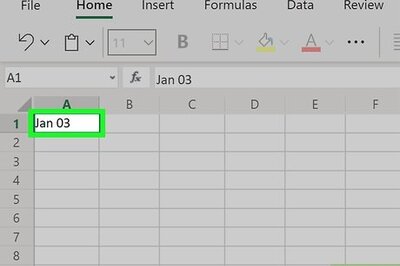
views
New Delhi: The Bharatiya Janata Party (BJP) on Monday released its 'Sankalp Patra' (vision document) for the upcoming Lok Sabha elections. The party, while applauding itself in the document over "anchoring retail inflation at four per cent", did not lay out a future course of action on the issue.
News18.com fact-checked the government’s claim and found that it has indeed been able to curb price rise driven largely by a significant fall in crude oil prices in the international market and a contraction (deflation) in food prices during its tenure.
According to data published by the Ministry of Statistics and Programme Implementation (MoSPI), the government has been able to keep retail inflation or Consumer Price Index (CPI) within Reserve Bank of India’s (RBI) mandated flexible inflation target of 4 (+/- 2) per cent for most part of its tenure.
The CPI for the month of May in 2014, when the Modi government assumed power at the Centre, stood at 8.33 per cent (year-on-year). This saw a steady rise over the next couple of months and came down substantially to settle at 4.28 by the year-end. The rate saw a further decline and fell below the RBI’s lower tolerance limit (2 per cent) to a low of 1.46 per cent in June 2017.
The CPI for February this year was pegged at 2.57 per cent (year-on-year).
Madan Sabnavis, chief economist at CARE Ratings, said that fortunately for the NDA government, low oil prices and no nationwide draught ensured the inflation remained under control in the last five years. These were the key reasons behind double-digit inflation during the UPA tenure.
"Ironically, the government has actually marked oil product prices to market with no subsidy on petrol and diesel, as well as raised prices of farm products through the MSP programme. Yet, as the MSP has not been very effective, prices have been reined in," Sabnavis said.
"Also, the global economy has been stagnant, which meant low commodity prices of products such as grains and metals. The RBI has also held on to rates or increased the repo to control demand pull inflationary forces," Sabnavis added.
But while the BJP has been able to control inflation to a great extent, it hasn’t kept all of its promises with regards to ‘price rise’.
The party, in its manifesto for the 2014 Lok Sabha elections, had promised to “to rein in inflation” through several institutional measures. In the run-up to the 2014 elections, it had promised to “put in place strict measures and special courts to stop hoarding and black marketing.”
However, no such courts have been set up in the last five years and the only action taken has been limited to advising state governments for a strict enforcement of Essential Commodities Act, 1955.
Additionally, the party had promised to “unbundle Food Corporation of India (FCI) operations into procurement, storage and distribution for greater efficiency.” On this, the government appointed a high-level committee to look into the restructuring of the FCI, which recommend not to unbundle the FCI operations. No further progress has been made on the matter.
Apart from this, the party has put in place a ‘Price Stabilisation Fund’, and a ‘National Agriculture Market’, which it had promised as other measures to tackle inflation.
The Downside to ‘Too Low’ an Inflation Rate
The rate of inflation is derived from the average rate of increase in the prices of a basket of goods and services, which is representative of all the goods and services that a household usually consumes. Roughly, 40 to 45 per cent of this basket is derived from ‘food and beverages’.
The slide in inflation in the country has come largely on the back of a ‘negative inflation’ or deflation (fall in prices) in food prices, apart from falling crude oil prices (7 per cent of the basket).
A negative inflation rate on food items, which includes vegetables, fruits, cereals, and dairy products, etc., is problematic for the farmers.
Food inflation stood at 8.88 per cent in May 2014, when the NDA took over the reins from the Congress-led United Progressive Alliance (UPA). It witnessed a continuous fall under the NDA government and went negative for the first time under its tenure in May 2017 to -0.22 per cent.
According to official data available till February 2019, food inflation in the country has remained negative since October 2018. It was -0.14 per cent in October, -1.69 per cent in November, -1.64 per cent in December, -1.29 per cent in January and -0.07 per cent in February.
According to Sabnavis, while low inflation for food has meant that consumers have benefited, farmers have received lower incomes.
He said, "Notwithstanding the higher MSPs announced, the procurement has been limited to rice and wheat where FCI has the machinery. Also, procurements through cooperatives have been region specific rather than across the country. This has definitely meant lower income for farmers in the absence of significantly higher production numbers. Farming is a zero-sum game where either the farmer/middleman or consumer has to gain while the other loses."
With negative food inflation and farmers facing the brunt of it, the promise to double farmers’ income by the BJP—in 2014 as well is in the latest manifesto—remains in question.



















Comments
0 comment